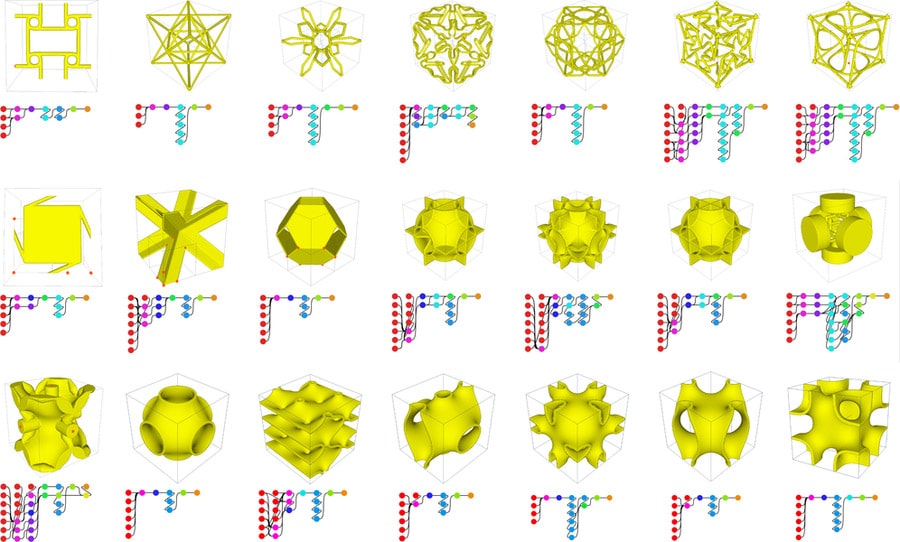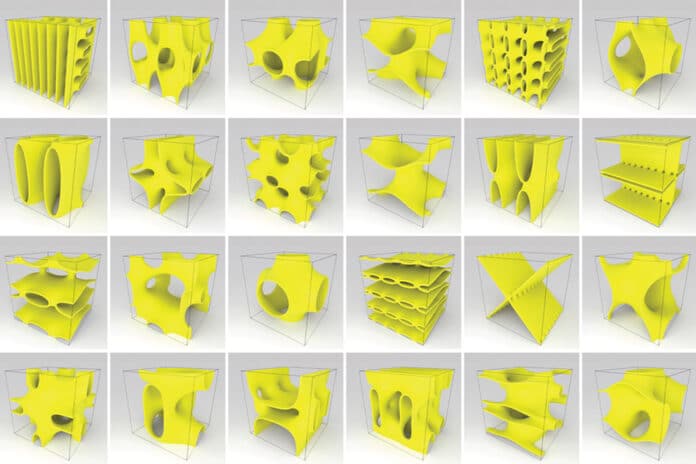Metamaterials are structures of long-standing interest, as they induce material properties that differ from those of their constituent base material(s). Metamaterials often exhibit behaviors not found in nature, such as tuneable compliant, chiral, auxetic, and non-reciprocal behaviors.
The behavior of a given metamaterial is primarily governed by its cellular architecture, which is the regular or random spatial arrangement of solid regions and voids used to fill a designated volume. But knowing which cellular structure will lead to the desired properties is difficult. Hence, engineers can manually explore only a small fraction of all the cellular metamaterials that are hypothetically possible.
A computational method created by researchers from MIT and the Institute of Science and Technology Austria makes it simpler for users to quickly design a metamaterial cell from any of those smaller building components and then assess the properties of the finished metamaterial.
Their method, similar to a specialized computer-aided design (CAD) system for metamaterials, enables an engineer to swiftly model even very complicated metamaterials and experiment with designs that could have otherwise taken days to construct. Since all the necessary building elements are available to the user, they can also explore the whole space of potential metamaterial shapes thanks to the user-friendly interface.
MIT electrical engineering and computer science graduate student Liane Makatura said, “We came up with a representation that can cover all of the different shapes engineers have traditionally shown interest in. Because you can build them all the same way, you can switch between them more fluidly.”
While developing cellular metamaterials, scientists normally start by choosing a representation describing the potential designs. This choice determines the set of shapes that will be available for exploration.

However, this prevents them from exploring metamaterials based on other elements, such as thin plates or 3D structures like spheres. These forms are provided via various representations, but there has yet to be a single approach that can be used to describe all shapes.
Makatura said, “By choosing a specific subspace ahead of time, you limit your exploration and introduce a bias based on your intuition. While this can be useful, intuition can be incorrect, and some other shapes may have also been worth exploring for your particular application.”
Scientists took a step back and carefully observed different metamaterials. They saw that lower-dimensional shapes could describe the shapes that make up the overall structure; for example, a beam could be reduced to a line or a thin shell to a flat surface.
They also observed that cellular metamaterials frequently contain symmetries, necessitating the representation of only a small portion of the entire structure. The rest can be put together by rotating and mirroring the first component.
By combining these two observations, scientists came up with the idea that cellular metamaterials could be well-represented as a graph structure.
Users construct a metamaterial skeleton using their graph-based representation using vertices and edge construction blocks. For instance, one places a vertex at each endpoint of the beam and connects them with a line to construct a beam structure.
The thickness of the beam is then specified using a function over that line, which the user can adjust such that different parts of the beam have different thicknesses.
Similar steps apply when dealing with surfaces; first, the user marks the vertices of the most crucial features before selecting a solution that infers the rest of the surface.
Users can also quickly build a triply periodic minimum surface (TPMS), a highly complex type of metamaterial, using these simple-to-use solvers. These structures are extraordinarily strong, but their typical development could be more complex and prone to mistakes.
Makatura said, “You can also start combining these shapes with our representation. Perhaps a unit cell containing a TPMS structure and a beam structure could give you interesting properties. But so far, those combinations haven’t been explored to any degree.”
The system outputs the full graph-based approach, including all the vertices, edges, solvers, transformations, and thickening operations the user used to arrive at the final structure.
Designers can preview the present structure at any stage of construction and immediately forecast specific characteristics, such as stiffness, within the user interface. Once an acceptable design is found, the user can iteratively adjust various parameters and reevaluate the result.
Using their system, scientists recreated structures that spanned many unique classes of metamaterials. After designing the skeletons, each metamaterial was generated within a few seconds.
Additionally, they developed automatic exploration algorithms, giving each one a set of guidelines before releasing it into their system. A computer program returned over 1,000 potential truss-based constructions in one experiment in approximately an hour.
The team also conducted a user study with ten people with minimal prior modeling experience with metamaterials. All six offered structures could be successfully modeled by the users, and most of them thought that the procedural graph representation facilitated the task.
Makatura said, “Our representation makes all sorts of structures more accessible to people. We were especially pleased with users’ ability to generate TPMS. These complex structures are usually difficult even for experts to generate. Still, one TPMS in our study had the lowest average modeling time out of all six structures, which was surprising and exciting.”
In the future, scientists would like to enhance their technique by including more complex skeleton thickening procedures so that the system can model a wider variety of shapes. They also want to continue exploring the use of automatic generation algorithms.
Journal Reference:
- Liane Makatura, Bohan Wang, Yi-Lu Chen et al. Procedural Metamaterials: A Unified Procedural Graph for Metamaterial Design. ACM Transactions on Graphics. DOI: 10.1145/3605389
